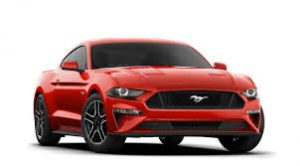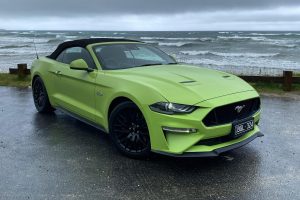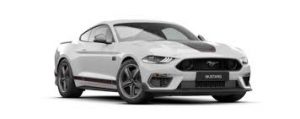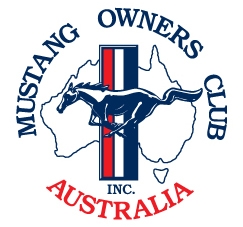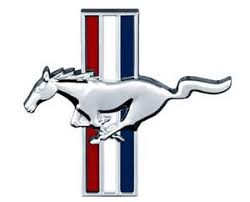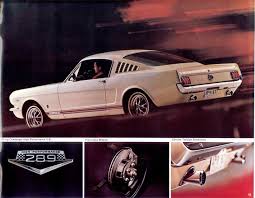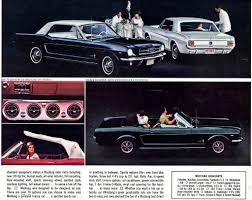Mustang Models
1964-1973 : 1st Generation
1964½
The Pony Car
In the early 1960s, Lee Iacocca, Vice-President and General Manager of Ford USA, envisioned a sporty youth-market car and functional fun car based on the compact Falcon.
Developed in record time on a shoe-string budget, Ford introduced the Mustang at one of the greatest showrooms of all time, New York World’s Fair on April 17, 1964, to instant acclaim.
Ford USA planned for 100,000 car sales in the first-year, but dealers sold 22,000 cars on the first day.
After the Ford Model A, the Ford Mustang became the company’s most successful car model. Some people call it the “Ultimate Classic Car.” The Mustang was a trendsetting design, creating a brand new car class called the ‘pony car’. The car was named after the P-51 Mustang, a fighter plane used during World War II.
Ford marketed the original Mustang as a 1965 model, though Ford made several production changes to cars built after August 1964, by which time Ford had already sold 120,000 cars. Hobbyists refer to early Mustangs as “1964½” models built between March and August 1964 at Ford’s Dearborn, Michigan Assembly Plant, while post-August cars are “late” 1965s.
The Mustang launched with Convertible and Hardtop body styles, with the Fastback joining the line-up as a late 1965 option.
A plethora of options enabled buyers to configure their Mustang as anything from an economical runabout to a weekend race car.
Total sales for the 1964½ model was 121,538 (28,833 Convertibles and 92,705 Hardtops).
The original engine line-up consisted of a 170-cid straight-six (2.8 litre), 260-cid (4.3 litre) V-8, and the legendary 289-cid (4.75 litre) V-8 with up to 271 horsepower.
1965
Total sales for the 1965 model was 559,451—nearly seven times Ford’s projections (73,112 Convertibles, 409,260 Hardtops, 77,079 Fastbacks).
For late ’65, the six cylinder was enlarged to 200 cid (3.3 litres) and the 260 was replaced by a 289 with a two-barrel carburettor.
Ford introduced the 289 2V V8, 289 4V V8 and the 289 4V V8 High Performance engines.


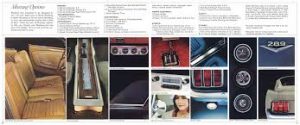
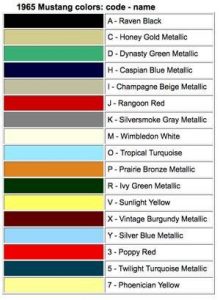
1966
The Mustang roared into 1966 with only minor changes, and on March 1 of that year, Ford built the millionth Mustang.
This was the end of the original body design covering 1964½ – 1966 models.
Total sales for the 1966 model was 607,568 (72,119 Convertibles, 499,751 Hardtops, 35,698 Fastbacks).
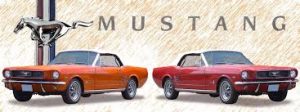
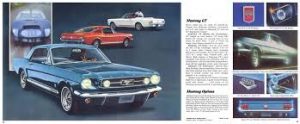

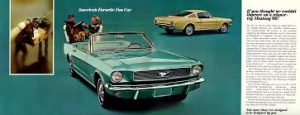
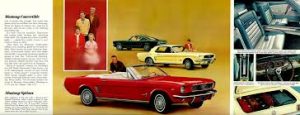
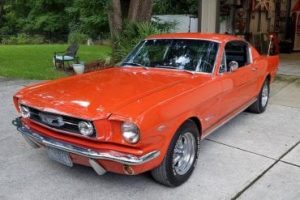
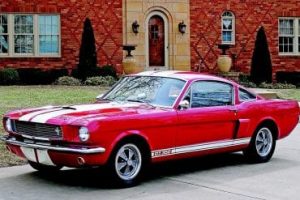
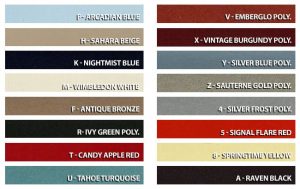
1967
The year 1967 saw the first major changes to the Mustang. The car grew in length, width, and weight, primarily to allow the installation of a big-block engine. The 390-cid (6.4 litre) V-8 produced 335 hp, displacing the 289 as the top performer. Interior and exterior trim were revised, and a new 302-cid (4.9 litre) V-8 replaced the higher-horsepower 289s. For drag racing, Ford offered a 428-cid (7.0 litre) Cobra Jet V-8 rated at 335 hp and 440 lb-ft of torque. The body design also covered 1968 models.
Total sales for the 1967 model was 472,121 (44,808 Convertibles, 356,271 Hardtops, 71,042 Fastbacks).
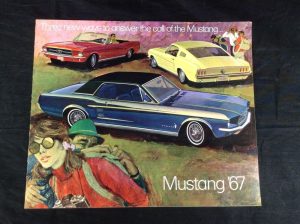

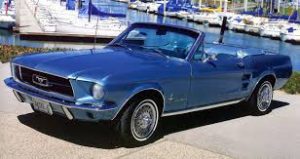

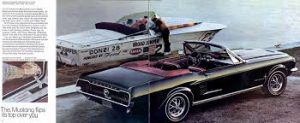
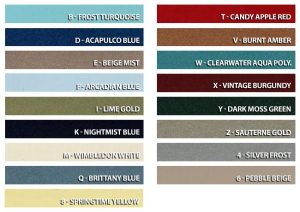
1968
Total sales for the 1968 model was 317,404 (25,376 Convertibles, 249,447 Hardtops, 42,581 Fastbacks).





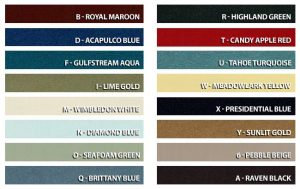
1969
In 1969, the Mustang got bigger still — 3.8-inches longer and half an inch wider, with no change in the 108-inch wheelbase.
Ford dropped the 289 and added a new 351-cid (5.8 litre) V-8 with 250 or 290 hp. New models included the Mach 1 and the Boss homologation models. The Boss 302 was built to meet Trans-Am racing production requirements, while the Boss 429 put the 375-hp, 429-cid (7.0 litre) engine into street use as required by NASCAR rules.
Total sales for the 1969 model was 299,824 (14,746 Convertibles, 150,640 Coupes, 134,438 Sportsroofs).


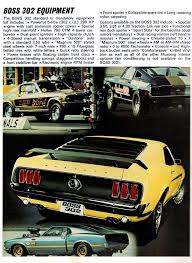
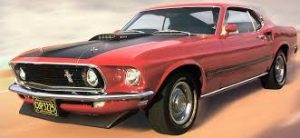
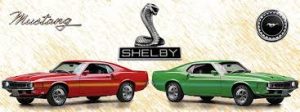

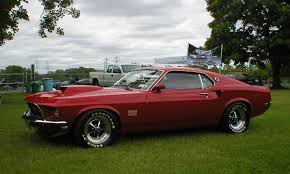

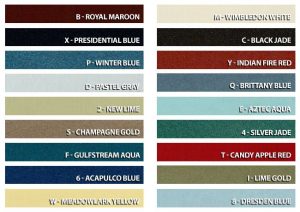
1970
With sales waning, Ford restyled the 1970 models to look less aggressive. Sales dipped to fewer than 300,000 in 1969 and sank past 200,000 in 1970.
Total sales for the 1970 model was 190,727 (7,673 Convertibles, 96,150 Coupes, 86,904 Sportsroofs).



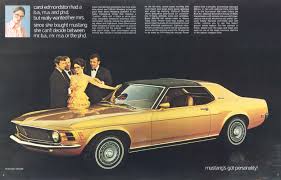

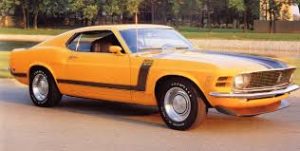

1971
For 1971, the Ford Mustang gained yet more size and bulk, and a new buttressed rear window gave the sedan a distinctly different profile than earlier Mustangs. As emissions rules tightened and Americans moved away from muscle cars, engine choices eroded. The six was enlarged to 250 cid (4.1 litres), with the 302-2V, 351-2V, 351-4V, 351-4V Boss and the 429 CJ the only engines on offer.
Total sales for the 1971 model was 149,678 (6,121 Convertibles, 83,102 Coupes, 60,455 Sportsroofs).
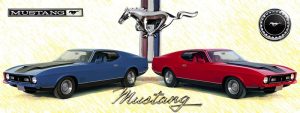
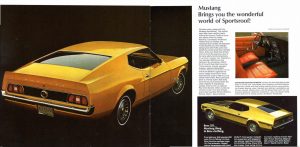
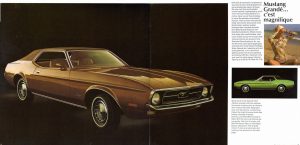

1972
The engines on offer were the 250 cid (4.1 litres), 302-2V, 351-2V, 351-4V, 351-4V HO.
Total sales for the 1972 model was 125,093 (6,401 Convertibles, 85,025 Coupes, 33,667 Sportsroofs).
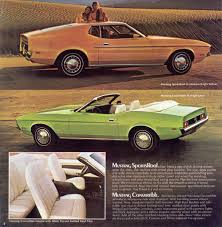
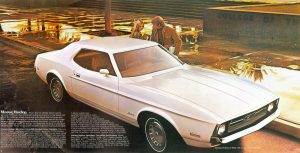


1973
By 1973, the Coupe’s weight had ballooned to 3,600 pounds, 1,200 pounds heavier than the 1965 Mustang. Sales continued to nosedive; aside from General Motors and Ford, most automakers had ditched their pony cars by this time, but Ford had something completely different in the works.
Total sales for the 1973 model was 134,867 (11,853 Convertibles, 76,754 Coupes, 46,260 Sportsroofs).
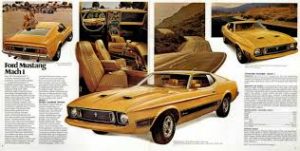




1974-1978 : 2nd Generation
The Incredible Shrinking Mustang II
1974
Those who complained the Mustang had gotten too fat were about to see their concerns addressed. For 1974, Ford introduced the Mustang II, a subcompact based on a stretched Pinto platform and available as a Notchback or Hatchback. Engine choices were a 140-cid (2.3 litre) four-cylinder or a 171-cid (2.8 litre) V-6. Ford pitched the Mustang II as an upscale economy car, with the luxury-themed Ghia topping the line-up. The Mustang II arrived in September 1973, just in time for the oil embargo, and the timing could not have been better: Sales rocketed to 386,000 for ’74, the Mustang II’s best year. Contemporary reviews were overwhelmingly positive, and the Mustang II won Motor Trend‘s 1974 Car of the Year Award.
As oil started to flow in ’74, Americans returned to big cars. Ford shoe-horned in the 302 (4.9 litre) V-8 (labelled as a 5.0L), which produced a timid 140-hp, and Ford offered Cobra II and King Cobra models that were eye-catching if not particularly quick. Sales held at not quite 200,000 per year for 1975-78. By the late 1970s people were ready for the return of a real Mustang, and Ford gave it to them.
1974 models were: Hardtop, Hatchback, Mach 1, and Ghia.

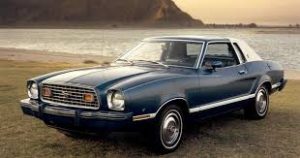
1975
The 1975 model year reintroduced the 302 cu in (4.9L) Windsor V8 that was only available with the C-4 automatic transmission, power brakes, and power steering. This continued through production’s end in 1978.
Other transmissions were the RAD four-speed with unique gearing for all three engines, and the C-3 automatic behind the 2.3L and 2.8L.
Changes introduced for 1975 included the availability of an “MPG” model which had a different rear axle ratio for better fuel economy.
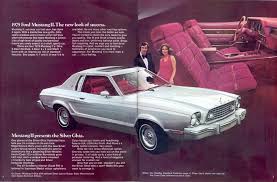
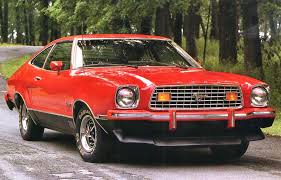
1976
1976 added the “Stallion” trim package. The Mach 1 remained through the life cycle 1974–1978. Other changes in appearance and performance came with a “Cobra II” version in 1976–1978.
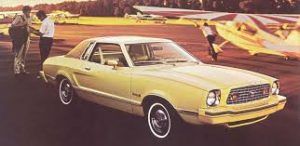
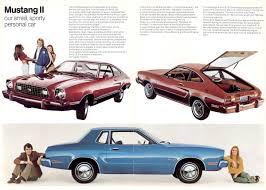
1977
The 1977–1978 Hatchback models in all trim levels were now available with the T-top roof option, which included a leatherette storage bag that clipped to the top of the spare tire hump.
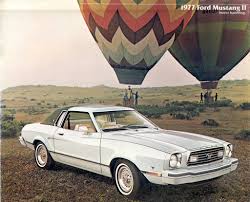
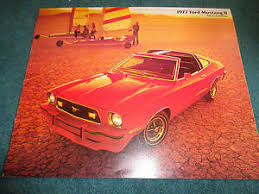
1978
Other changes in appearance and performance came with a “Cobra II” version in 1976–1978 and a “King Cobra” in 1978 of which around 4,972 were built.
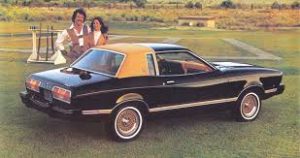
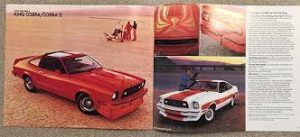
1979-1993 : 3rd Generation
The Fox Body
1979
The new-for-1979 Mustang rode on a new platform called Fox, which it shared with the Fairmont sedan. The larger body with an increased wheelbase yielded more interior space for four passengers, especially in the back seat, as well as a larger capacity trunk and a bigger engine bay. Available in both Notchback and Hatchback styles, the new Mustang offered a 2.3-litre four-cylinder engine in naturally aspirated (88-hp) and turbocharged (132-hp) form, 2.8 litre V-6 (dropped later in the year), 3.3 litre I-6, and the 4.9 V-8 still labelled as a 5.0L.
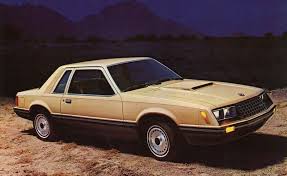
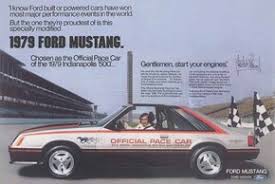
1980
Ford replaced the 4.9L with a 4.2L V-8 for the 1980 model year, just in time for the second oil crisis.
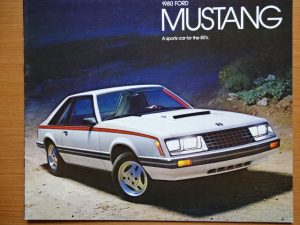
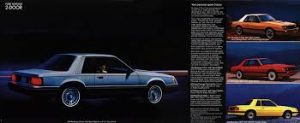
1981
Ford also replaced the 4.9L with a 4.2L V-8 for the 1981 model year, just in time for the second oil crisis.
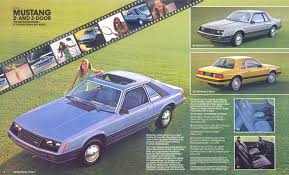
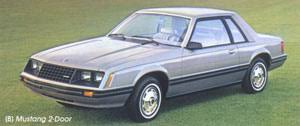
1982
Ford dropped the troublesome turbo for ’82, when the 4.9L/5.0L made its triumphant return. The bad news was that Ford was now building 140-mph Mustang Cop Cars.
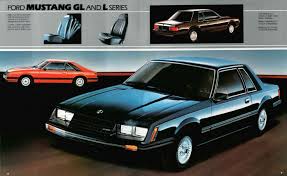
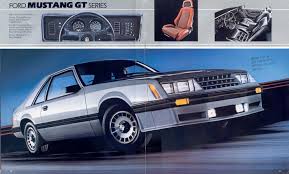
1983
As automakers got a handle on emissions tuning, real performance returned to the Mustang line-up. An improved 2.3 litre turbocharged engine returned for 1983, along with the first Convertible Mustang in a decade and a new 3.8 litre V-6 to replace the old straight-six. The V-8 was up to 175-hp.
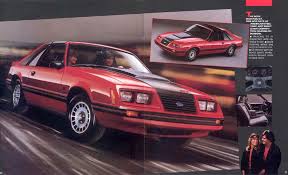
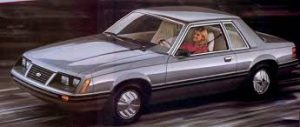
1984
In 1984 came the limited-run Mustang SVO, with a 175-hp 2.3T engine (later 205-hp) and a revised suspension featuring Koni adjustable shocks.
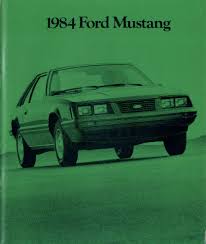
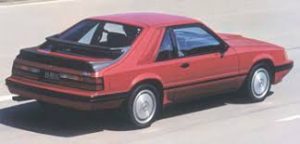
1985
In 1985 the new 5.0L HO (High Output) engine with 210-hp was delivered with a four-barrel carburettor.
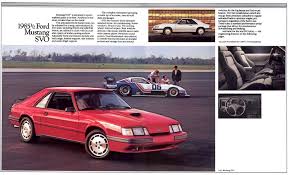
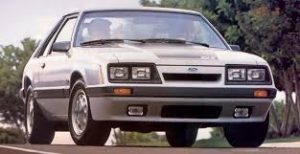
1986
In 1986, Ford swapped its four-barrel carburettor set-up for multi-port fuel injection and 200-hp.
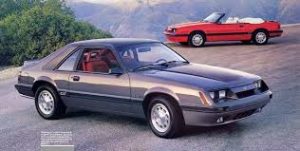
1987
When 1987 arrived, it brought a stunning redesign that featured Ford’s aero-themed styling, with flush headlights and a new interior. The V-6 was dropped, leaving two engines and two models: The economy-themed Ford Mustang LX and the flashy V-8 powered Ford Mustang GT, with its lower-body side skirts and louvered taillights. While most LX cars had the 88-hp, 2.3 litre engine, Ford made a stealthy LX 5.0L that combined the V-8’s 225-hp (205-hp after 1988) with the LX’s tame looks. Without the extra 200 pounds of body cladding, it had a performance edge over the GT.
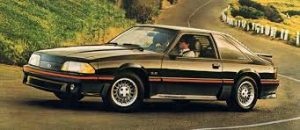


1988
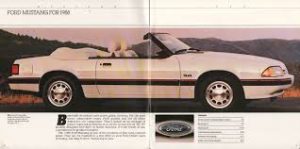
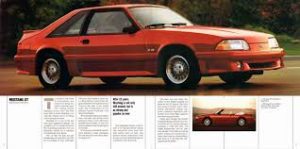
1989
Sales began to decline after 1989, and with a new Mustang in the wings, changes were minor. In 1993, Ford gave us a going away present: The SVT Cobra, with a highly-modified 235-hp V-8, Tokico shocks and struts, and less aggressive styling than the GT. The race-ready Cobra R jettisoned extra weight in the form of the A/C, stereo, back seat, sound insulation, and power accessories—and added chassis braces, Eiback springs, and adjustable Koni dampers. Ford built fewer than 5,000 SVT Cobras and only 107 Cobra Rs.

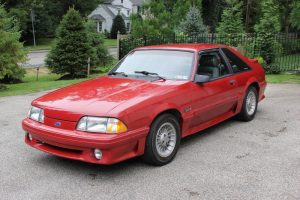
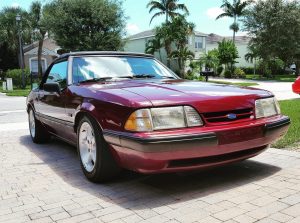
1990
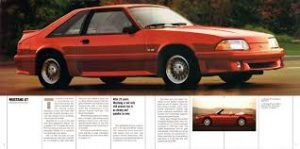


1991

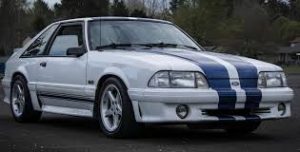


1992

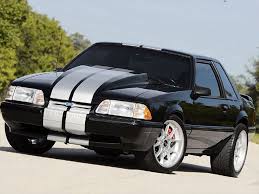
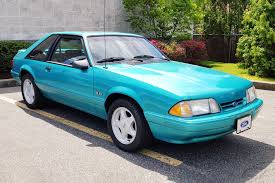
1993
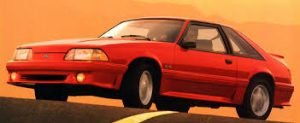



1994-2004 : 4th Generation
Mustang Returns to its Roots (SN95)
1994
In November 1993, the Mustang debuted its first major redesign in fifteen years. Code-named “SN-95” by the automaker, it was based on an updated version of the rear-wheel drive Fox platform called “Fox-4.” The new styling by Patrick Schiavone incorporated several styling cues from earlier Mustangs. For the first time since its introduction 1964, a Notchback coupe model was not available. The door windows on the coupe were once again frameless; however, the car had a fixed “B” pillar and rear windows.
The resemblance was clearer in the cabin, which featured a stylized version of the original Mustang’s twin-cowl dashboard.
Under the skin the new Mustang had a stiffened and enlarged version of the Fox platform. The suspension was tuned for a softer ride with comparable handling, though critics lamented its more benign understeering nature. The 4.9 litre V-8 returned with 215-hp, and the new base engine was a stout 3.8 litre V-6. In 1996, Ford replaced the 4.9L with the “modular” 4.6 litre OHC V-8. Output was similar to the 4.9L, but the engine was criticized for a lack of low-end torque. A more powerful limited-run SVT Cobra remained in the line-up.
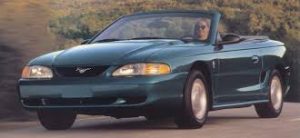
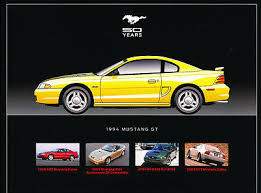
1995
The base model came with a 3.8 OHV V6 3.8L (232 cu in) engine rated at 145-hp (108 kW) in 1995, and was mated to a standard 5-speed manual transmission or optional 4-speed automatic. Though initially used in the 1994 and 1995 Mustang GTS, GT and Cobra, Ford retired the 302 cid pushrod small-block V8 after nearly 30 years of use.
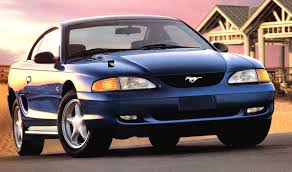
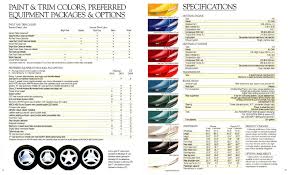
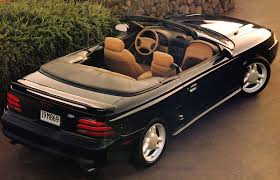
1996
The base model came with a 3.8 OHV V6 3.8L (232 cu in) engine rated at 150-hp (110 kW) in 1996, and was mated to a standard 5-speed manual transmission or optional 4-speed automatic.
A new 4.6L (281 cu in) SOHC V8 option was available in the 1996 Mustang GT. The 4.6L V8 was initially rated at 215-hp (160 kW) in 1996–1997.
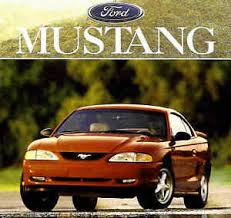
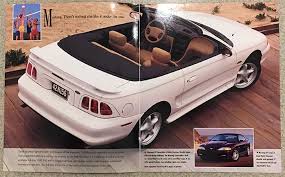
1997
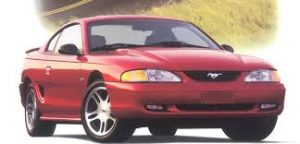
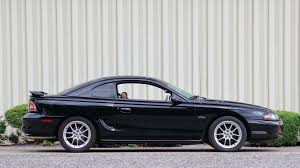
1998
The 4.6L V8 was increased to 225-hp (168 kW) in 1998.

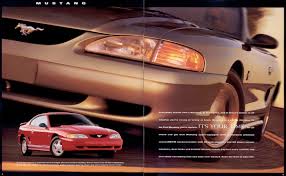
1999
For 1999, the Mustang was reskinned with Ford’s New Edge styling theme with sharper contours, larger wheel arches, and creases in its bodywork, but its basic proportions, interior design, and chassis remained the same as the previous model. The Mustang’s powertrains were carried over for 1999, but benefited from new improvements. The standard 3.8 L V6 had a new split-port induction system, and was rated at 190-hp (140 kW) 1999–2000, while the Mustang GT’s 4.6L V8 saw an increase in output to 260 bhp (190 kW) (1999–2004), due to a new head design and other enhancements.
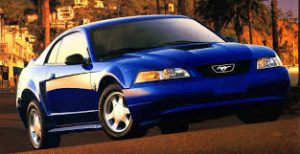
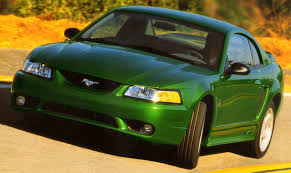
2000
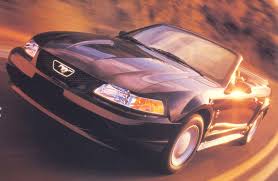

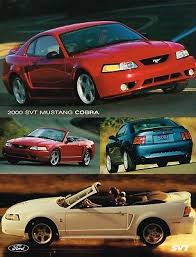
2001
In 2001, the 3.8L was increased to 193-hp. The 2001 Bullitt (320 bhp) was introduced.
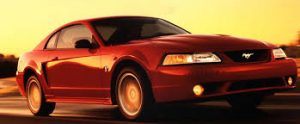

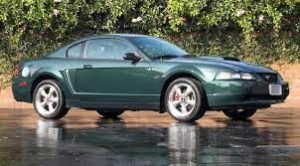
2002

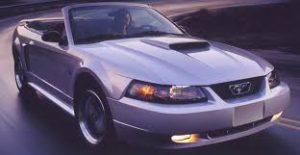
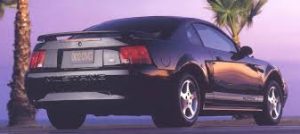
2003
In 2003 and 2004, the Mach 1 and the 390-hp (290 kW) Cobra 3.8L were introduced.
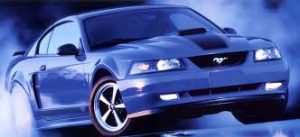


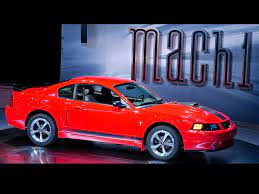
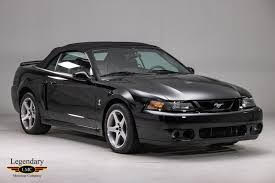
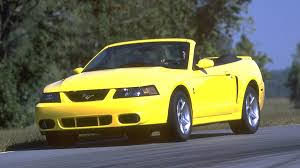
2004



2005-2014 : 5th Generation
Mustang Goes Retro (S197)
2005
The 2005 Mustang debuted with a squared-off shape that payed proper homage to the first-generation Mustang. Ford had finally ditched the 25-plus-year-old Fox platform, though the new Mustang retained its live rear axle in order to keep costs down, a move the automotive press harshly criticized. The base V6 Mustang used a 4.0 litre V-6 that produced 210-hp, while the 4.6 litre V-8 was now up to 300-hp. Consumer reaction was so positive that General Motors embarked on its own program to bring back the Camaro while Chrysler resurrected the Dodge Challenger.
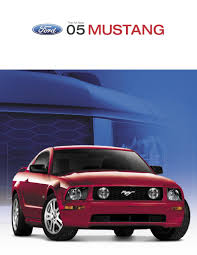
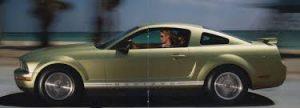
2006
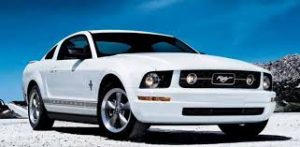
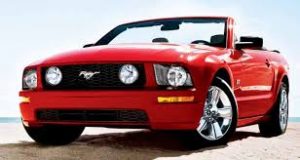
2007
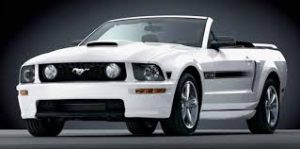
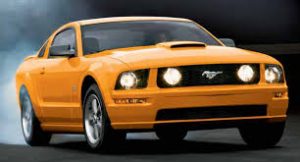
2008
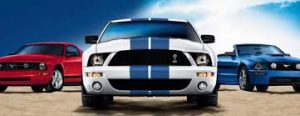
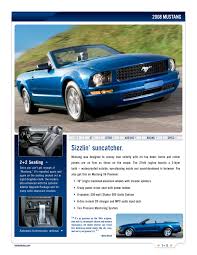
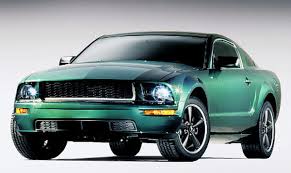
2009
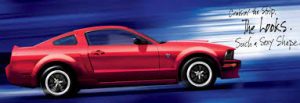
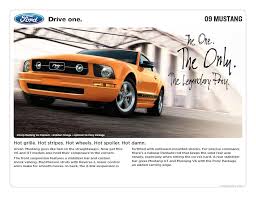
2010
The fifth-generation Mustang got a facelift in 2010, just in time to greet the new Camaro. One of the styling highlights was the sequential taillights, though the original Mustang never had them (the ’64 Thunderbird, ’67 Mercury Cougar, and ’68 Shelby’s did).
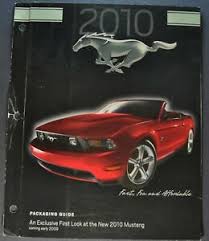
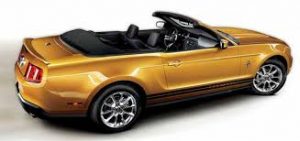
2011
The year 2011 brought new engines: A 3.7 litre V-6 with 305 bhp and a new 5.0L V-8 that actually displaced 5.0 litres and put out an impressive 412-hp.
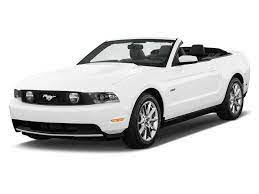
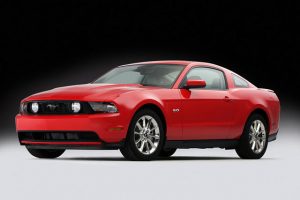
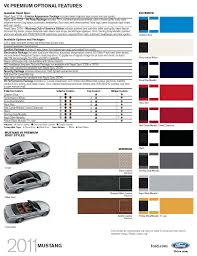
2012
The 2012 Boss 302 upped the power to 444-hp, while the Boss 302 Laguna Seca edition was a proper track-ready car.
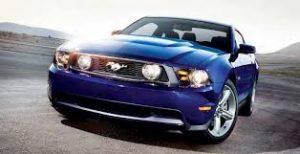


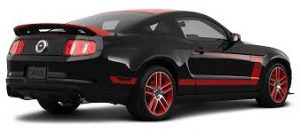
2013
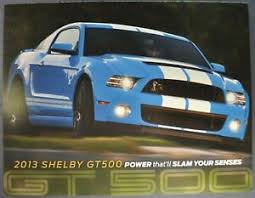
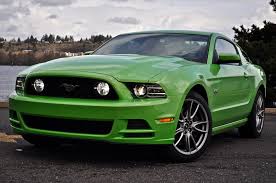
2014
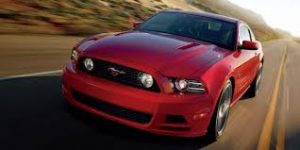
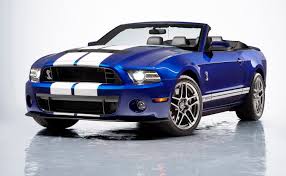
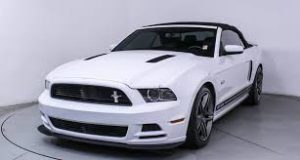
2015 – Today : 6th Generation
The Modern Mustang (S550)
2015
Ford revealed the latest iteration of the Mustang in December 2013 as a 2015 model celebrating the Mustang’s 50th anniversary. Changes include a body widened by 1.5 inches and lowered 1.4 inches, a trapezoidal grille, and a 2.75-inch lower decklid, as well as new colours. The passenger volume is increased to 84.5 cubic feet, the wheelbase is still 8 ft. 11.1 in. (107.1 in.), and three engine options are available: a newly developed 2.3 L EcoBoost 310-hp four-cylinder introduced to reach high tariff global markets like China, 3.7L 300-hp V6, or 5.0L Coyote 435-hp V8, with either a Getrag six-speed manual or six-speed automatic transmission with paddle shifters.
An independent rear suspension was finally fitted as standard equipment, and the 300-hp V-6 and 435-hp V-8 were complemented by a new 310-hp, 2.3 litre turbocharged four-cylinder.
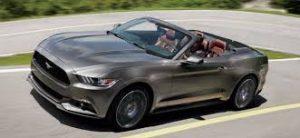



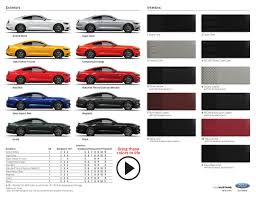
2016
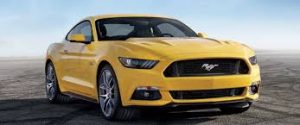

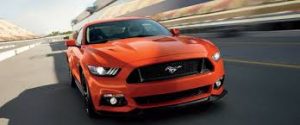
2017
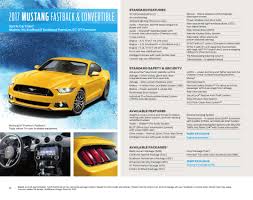

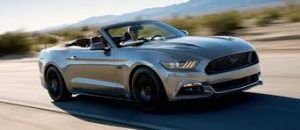
2018
The 2018 model year Mustang was released in the third quarter of 2017 in North America and by 2018 globally. It featured a minor redesign to the exterior. The 2018 Mustang engine line up was revised. The 3.7L V6 was dropped and the 2.3L I4 Ecoboost (direct-injection turbocharged) engine now serves as the base power plant for the Mustang, producing 310-hp (231 kW) and 350 lb⋅ft (475 N⋅m) of torque when using 93-octane fuel. The 5.0L V8 gets a power increase to 460-hp (343 kW) and 420 lb⋅ft (569 N⋅m) of torque. The automatic transmission in both engines is now a ten-speed Ford 10R80.
In January 2018, Ford displayed a prototype of the special edition 2018 Bullitt model, to be released in the summer; this vehicle commemorated the 50th anniversary of the movie Bullitt that helped attract interest in the marque.



2019
For the 2019 model year, Ford revised many components on the 2019 Shelby GT350 including stickier Michelin Pilot Sport Cup 2 tyres along with steering and suspension components.
Ford also announced a new four-door electric crossover to be marketed as the 2020 Mustang Mach-E (Electric model in the shape of a SUV).
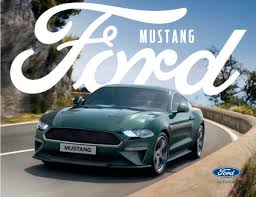

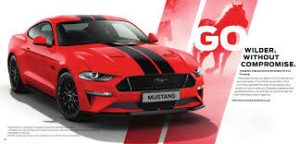

2020
The 2020 model year saw the re-introduction of the GT500. The 2020 GT500 includes a hand-built 5.2 litre “Predator” aluminium-alloy V8 engine with a 2.65 litre roots-type supercharger. The Shelby GT500 produces 760-hp (567 kW; 771 PS) and 625 lb⋅ft (847 N⋅m) of torque. The GT350 was discontinued at the end of the 2020 model year.
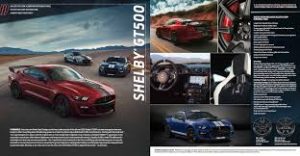
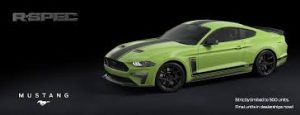
2021
For the 2021 model year, Ford re-introduced the Mach 1 after a 17-year hiatus. The 2021 Mach 1 utilizes the current Coyote 5.0L engine with GT350 parts, including the intake manifold, increasing performance to 480 hp (358 kW) at 7,000 rpm and 420 lb⋅ft (569 N⋅m) at 4,600 rpm in addition to utilizing the GT350’s lightweight Tremec six-speed manual transmission, oil-filter adapter, engine oil cooler, and front and rear subframe. The Mach 1 also utilizes parts from the GT500, including the rear axle cooling system, rear toe link, and rear diffuser.
